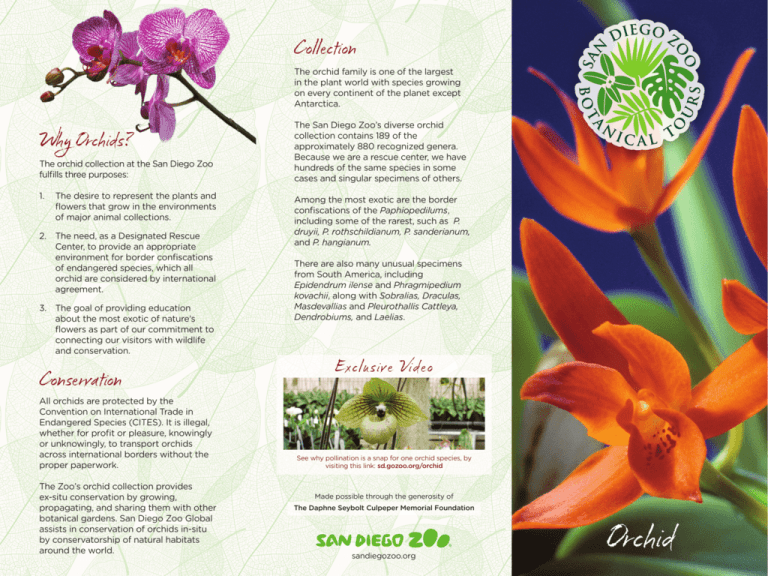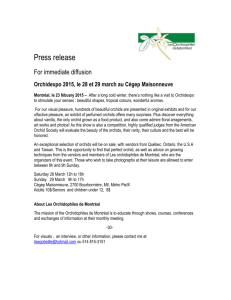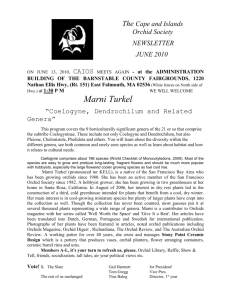Orchid - San Diego Zoo
advertisement

Collection The orchid family is one of the largest in the plant world with species growing on every continent of the planet except Antarctica. Why Orchids? The orchid collection at the San Diego Zoo fulfills three purposes: 1. The desire to represent the plants and flowers that grow in the environments of major animal collections. 2. The need, as a Designated Rescue Center, to provide an appropriate environment for border confiscations of endangered species, which all orchid are considered by international agreement. 3. The goal of providing education about the most exotic of nature’s flowers as part of our commitment to connecting our visitors with wildlife and conservation. Conservation All orchids are protected by the Convention on International Trade in Endangered Species (CITES). It is illegal, whether for profit or pleasure, knowingly or unknowingly, to transport orchids across international borders without the proper paperwork. The Zoo’s orchid collection provides ex-situ conservation by growing, propagating, and sharing them with other botanical gardens. San Diego Zoo Global assists in conservation of orchids in-situ by conservatorship of natural habitats around the world. The San Diego Zoo’s diverse orchid collection contains 189 of the approximately 880 recognized genera. Because we are a rescue center, we have hundreds of the same species in some cases and singular specimens of others. Among the most exotic are the border confiscations of the Paphiopedilums, including some of the rarest, such as P. druyii, P. rothschildianum, P. sanderianum, and P. hangianum. There are also many unusual specimens from South America, including Epidendrum ilense and Phragmipedium kovachii, along with Sobralias, Draculas, Masdevallias and Pleurothallis Cattleya, Dendrobiums, and Laelias. Exclusive Video See why pollination is a snap for one orchid species, by visiting this link: sd.gozoo.org/orchid Made possible through the generosity of The Daphne Seybolt Culpeper Memorial Foundation sandiegozoo.org Orchid Schomburgkia tibicinis FUN FACT Ants are known to take shelter in the dried, hollowed out bulbs of this species. Paphiopedilum sanderianum This plant imitates a large hairy spider. Mimicry is important to pollination in orchids. All orchid flowers have evolved to attract pollinators while maintaining the same basic floral structure: three sepals, three petals, and a central column. The unique petals of this orchid can reach lengths of 24 to 36 inches—they often touch the ground! This rare species was first discovered in 1885, but was not found again for about 100 years. This orchid blooms hidden under the leaves of the plant, just as a tarantula might. The blossoms are covered with stiff hairs, again like a tarantula! The long petals act as a “ladder” that pollinating insects climb to access the flower’s pollen. Paphiopedilum tigrinum This orchid’s seed pod is the source of vanilla beans. Vanilla production is the most labor intensive agricultural crop in the world. As the name suggests, this orchid doesn’t like the light of day. The bizarre blossoms tend to wither rather quickly as the sun rises. This critically endangered species is a delight to see in bloom with its striking maroon and yellow blossoms. It first entered the Zoo’s collection in 1990 as a plant confiscation. Because of its economic importance, this plant is also called the “orchid of commerce.” Orchids are often thought of as needing heat, but this species grows in the cool cloud forests of South America. FUN FACT Dracula vampira FUN FACT Vanilla planifolia The San Diego Zoo is a plant rescue center for plants imported without the proper permits. Polyrrhiza lindenii Cattleya aurantiaca This plant is often called Darwin’s orchid because of his study of it. Darwin predicted that a pollinator of this flower would need to have a long tongue, and he was right! It turned out to be a then-unidentified type of sphinx moth. Native to southern Florida, this leafless orchid goes unnoticed until its large white flower appears. Because of this, it is sometimes called “ghost orchid.” Unlike most Cattleya orchids, this plant’s blossoms are only an inch wide, but are very fragrant. This species is native to the low mountains and tropical rain forests of Mexico and El Salvador. The word sesquipedale in this orchid’s scientific name is Latin for “one and a half feet”—a reference to its long nectar channel. This orchid was made famous by the books, The Orchid Thief and Orchid Fever, and the movie “Adaptation.” FUN FACT Angraecum sesquipedale FUN FACT FUN FACT FUN FACT FUN FACT Look for this large sized epiphytic orchid attached to the trees at the top of Fern Canyon Trail, just off Treetops Way. Pleurothallis tarantula FUN FACT orchids Most of these can be found in the Orchid Greenhouse near Map Locator 10, which is open to the public at specific times each month. The name “aurantiaca” means orange in Latin, describing the color of this orchid’s blooms. Collection The orchid family is one of the largest in the plant world with species growing on every continent of the planet except Antarctica. Why Orchids? The orchid collection at the San Diego Zoo fulfills three purposes: 1. The desire to represent the plants and flowers that grow in the environments of major animal collections. 2. The need, as a Designated Rescue Center, to provide an appropriate environment for border confiscations of endangered species, which all orchid are considered by international agreement. 3. The goal of providing education about the most exotic of nature’s flowers as part of our commitment to connecting our visitors with wildlife and conservation. Conservation All orchids are protected by the Convention on International Trade in Endangered Species (CITES). It is illegal, whether for profit or pleasure, knowingly or unknowingly, to transport orchids across international borders without the proper paperwork. The Zoo’s orchid collection provides ex-situ conservation by growing, propagating, and sharing them with other botanical gardens. San Diego Zoo Global assists in conservation of orchids in-situ by conservatorship of natural habitats around the world. The San Diego Zoo’s diverse orchid collection contains 189 of the approximately 880 recognized genera. Because we are a rescue center, we have hundreds of the same species in some cases and singular specimens of others. Among the most exotic are the border confiscations of the Paphiopedilums, including some of the rarest, such as P. druyii, P. rothschildianum, P. sanderianum, and P. hangianum. There are also many unusual specimens from South America, including Epidendrum ilense and Phragmipedium kovachii, along with Sobralias, Draculas, Masdevallias and Pleurothallis Cattleya, Dendrobiums, and Laelias. Exclusive Video See why pollination is a snap for one orchid species, by visiting this link: sd.gozoo.org/orchid Made possible through the generosity of The Daphne Seybolt Culpeper Memorial Foundation sandiegozoo.org Orchid




